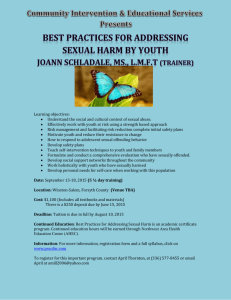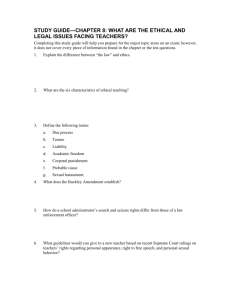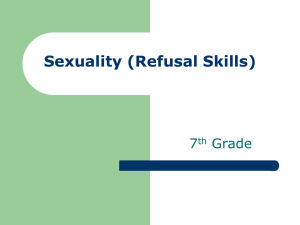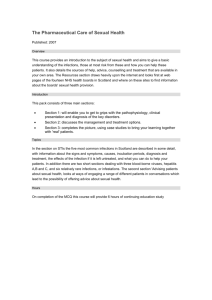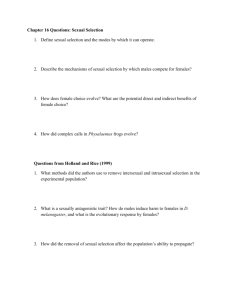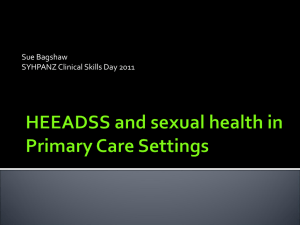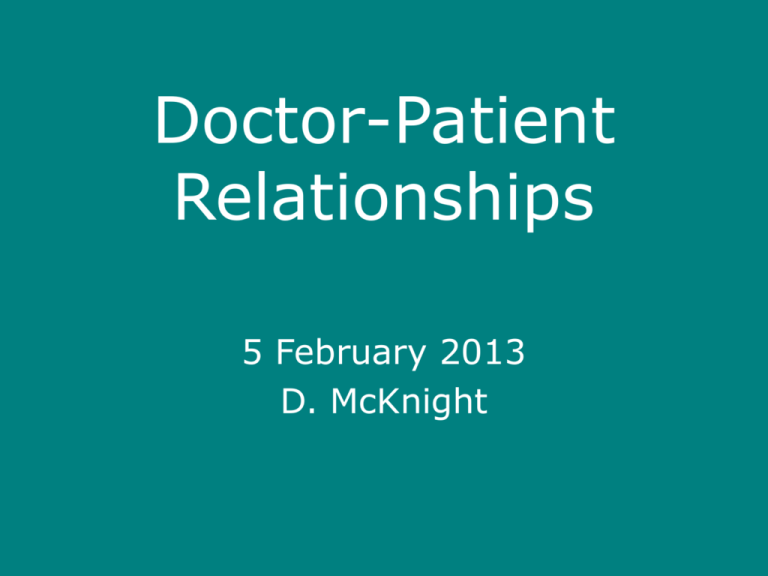
Doctor-Patient
Relationships
5 February 2013
D. McKnight
Médecins sans frontières
Doctors without Borders
Doctors WITH Boundaries
DOCTORS WITHOUT BOUNDARIES
3
What kind of boundary
violations cause trouble?
Mostly
Sex
& Money
Case – Dr G
• Dr G is a 34 year old gynecologist
• He has seen a 30 year old woman 3
times in the last month and now says
he does not need to see her again for
this problem
• She calls the next day and invites him
to attend a gallery opening with her
We will return to this case
CPSO
(and other regulatory Colleges)
• NO tolerance for sexual abuse of
patients
• mandatory loss of license
– cannot reapply for 5 years
– even then must prove low risk
• “ The patient started it”
is not an excuse
The Hippocratic Oath states that
physicians:
“…will come for the benefit of the sick,
remaining free of all intentional injustice,
of all mischief and in particular of sexual
relations with both female and male
persons be they free or slaves.”
Regulated Health Professions Act, 1991
S.O. 1991, CHAPTER 18
Consolidation Period: From October 25, 2010 to January 26, 2011
Last amendment: 2010, c. 15, s. 241.
• Under the RHPA, any form of
sexual relations between
physicians and patients is
considered to be sexual abuse.
• Consent by the patient is no
defence to sexual abuse.
SCHEDULE 2
HEALTH PROFESSIONS
PROCEDURAL CODE
Note: This Code is deemed by section 4 of the Regulated Health
Professions Act, 1991 to be part of each health profession Act.
Health Professions Procedural Code
Professional misconduct
51. (1) A panel shall find that a
member has committed an act of
professional misconduct if,
…
(b.1) the member has sexually
abused a patient; …
Health Professions Procedural Code
Sexual abuse of a patient
(3) In this Code, “sexual abuse” of a patient by a member
means,
(a) sexual intercourse or other forms of physical sexual
relations between the member and the patient,
(b) touching, of a sexual nature, of the patient by the
member, or
(c) behaviour or remarks of a sexual nature by the member
towards the patient. 1993, c. 37, s. 4.
Exception
(4) For the purposes of subsection (3), “sexual nature” does
not include touching, behaviour or remarks of a clinical
nature appropriate to the service provided. 1993, c. 37,
s. 4.
The Code provides for mandatory revocation of a
physician’s certificate of registration for certain
acts of sexual abuse.
•
•
•
•
•
sexual intercourse;
genital to genital, genital to anal, oral to genital,
or oral to anal contact;
masturbation of the member by, or in the
presence of, the patient;
masturbation of the patient by the member;
encouragement of the patient by the member to
masturbate in the presence of the member.
The Code provides for mandatory revocation of a
physician’s certificate of registration for certain
acts of sexual abuse. For sexual abuse that does
not involve these acts, the penalty is at the
discretion of the Discipline Committee.
If a physician’s certificate of registration is
revoked for sexual abuse, he or she cannot
reapply until five years after the revocation.
While it is not considered ‘sexual abuse’ under the
legislation, if sexual contact takes place after the
physician-patient relationship has been ended,
the physician may still be found to have
committed professional misconduct.
Physician-Patient Relationship
• depends on TRUST
• has inherent difference in POWER
TRUST
• TRUST at the core of notions of
Professionalism
• TRUST essential in the patient-doctor
relationship: patient depends on
– doctor’s knowledge & skill
– that doctor will act in patient’s interest
POWER
• balance of power favours doctor
– doctor has knowledge & skill
– patient tells private information
– patient permits intimate examination
• these are one-way transfers
• (at least ought to be !)
Sexual abuse of patients
Who is at risk? (doctors)
• Mentally ill: impaired judgment
• Naïve/uninformed:
poor training and judgment
• Masochistic: “save” patient, risks self
• Personality disorder
• Love-sick
D. Stewart
Who is at Risk?
Personality Disorder
•
•
•
•
•
Most common
Exploitive
Uses patients for gratification
Calculated
No remorse until caught
D. Stewart
Who is at risk?
Love-sick
• Second most common
• Personal stress / conflict
– often recent romantic break-up
•
•
•
•
•
May be depressed
Increased disclosure
Intrusive thoughts of patient
Feels “in love”
Rationalizes / denies
D. Stewart
Sexual abuse of patients
Who is at risk? (patients)
•
•
•
•
•
•
Depressed
Needy / lonely
Previous abuse
Psychotic / borderline
Low intelligence
Exploitative
D. Stewart
Patient Consequences
•
•
•
•
•
•
•
•
•
Lack of treatment for original complaint
Mistrust
Ambivalence
Guilt / shame
Isolation / loneliness
Somatic complaints
Depression / anxiety
Post traumatic stress disorder
Hospitalization / suicide
D. Stewart
PRINCIPLES
1. A physician, being in a position of trust and
power, has a duty to act in the patient’s best
interest.
2. Physicians must establish and maintain
appropriate professional boundaries with
patients.
3. Sexual activity and ‘romantic interactions’
interfere with the goals of the physician-patient
relationship and may obscure the physician’s
objective judgment concerning the patient’s
health care.
PRINCIPLES (cont’d)
4. Physician sexual misconduct is detrimental to the
physician-patient relationship, harms individual
patients and erodes the public’s trust in the
medical profession.
5. Patients must be protected from sexual abuse by
physicians.
Guidelines to help maintain boundaries
1.
Do not make or respond to sexual
advances with patients
2. Explain examinations:
scope & reason
3. Third party – offer to patient
–
provide protection to patient & doctor
–
if doctor cannot provide 3rd party,
allow patient to bring someone
Guidelines to help maintain boundaries
4. Touching for comfort can be
misinterpreted:
words may be better
Danger of appearing cold and uncomforting
• in most circumstances, holding hand or a
hand on the forearm will be acceptable
• some cultural variation
APPENDIX A
Guidelines for Maintaining Professional Boundaries
1. Avoid physical contact with a patient (except what is
required to perform medically necessary
examinations).
2. Use gloves when examining genitals.
3. Show sensitivity and respect for the patient’s privacy
and comfort at all times:
- avoid watching a patient dress or undress,
- provide privacy and appropriate covers and gowns.
4. Avoid any behaviour or remarks that may be
interpreted as sexual by a patient.
5. Endeavour to be aware and mindful of the
patient’s particular cultural or religious
background.
6. Do not make sexualized comments about a
patient’s body or clothing.
7. Do not criticize or comment unnecessarily on a
patient’s sexual [orientation].
8. Do not ask or make comments about sexual
performance except where the examination or
consultation is pertinent to the issue of sexual
function or dysfunction.
9. Do not ask details of sexual history or sexual
behaviour unless related to the purpose of the
consultation or examination.
10. Be cognizant of social interactions with patients
that may lead to romantic involvement.
11.Do not talk with your patients about your own
sexual [orientation], fantasies, problems,
activities or performance.
12. Learn to control the therapeutic setting and to
detect possible erosions in boundaries.
CPSO
Boundaries
Self-Assessment
Tool
Members’
Dialogue
September/October 2004
CPSO Boundaries Self-Assessment Tool
7.
9.
10.
11.
12.
Do I spend a disproportionate amount of time
thinking about particular patients?
Do I accept inappropriate gifts from patients?
Do I seek advice for personal benefit from a
patient during a clinical encounter?
Do I pay more attention to my personal
appearance if I know that I will be seeing a
certain patient?
Do I seek more personal details than I clinically
need to, in order to find out about a patient’s
personal life?
CPSO Boundaries Self-Assessment Tool
15. Do I share my personal problems with patients?
18. Do I tell patients personal things about myself
in order to impress them and if so, why?
20. When a patient has been seductive with me, do
I experience this as a gratifying sign of my own
sex appeal?
22. Do I ask patients to do personal favours for
me?
23. Do I undertake business deals with patients?
Boundary Warnings
• Always giving patient last appointment
• Self-disclosure
• Feeling in love with patient
– having intrusive thoughts about patient
• Meeting outside office
• Special treatment
• Activity you don’t want others to know
D. Stewart
Does a Physician-Patient Relationship
Exist?
• nature & frequency of treatment
• ongoing treatment
• billing
• duration important
• if in doubt, ask advice
Sex after ending Doctor-patient
relationship
“Ending the physician-patient relationship does not
eliminate the possibility that sexual contact
between a physician and a former patient may be
considered to be professional misconduct even
though it is not sexual abuse as defined in the
RHPA. This is because there may be continuing
trust, knowledge, or influence derived from the
previous professional relationship.”
Consider:
• the length and intensity of the former
professional relationship;
• the nature of the patient’s clinical problem;
• the type of clinical care provided by the
physician;
• the extent to which the patient has confided
personal or private information to the physician;
• the vulnerability the patient has in the physicianpatient relationship.
• For example, when the physician-patient
relationship involves a significant component of
psychoanalysis or psychotherapy, sexual
involvement with the patient is likely
inappropriate at any time after termination.
• However, if a physician saw a patient on one or
two occasions to provide routine clinical care, it
may not be inappropriate to have a sexual
relationship with the former patient within a short
time following the end of the physician-patient
relationship.
“ At all times, a physician has an
ethical obligation not to exploit the
trust, knowledge and dependence
that develops during the physicianpatient relationship for the
physician’s personal advantage.”
Persons closely associated
with patients:
• spouses or partners
• parents or guardians
• SDMs / power of attorney
Don’t have sex with them either.
Mandatory Duty to Report
11. Sexual Abuse by a Health Professional
When a physician has reasonable grounds,
obtained in the course of practising the
profession, to believe that another
physician or regulated health care
professional has sexually abused a
patient, the physician must file a report in
writing, with the Registrar of the College
to which the alleged abuser belongs.
11. Sexual Abuse by a Health Professional
The physician is not required to file a report
if he or she does not know the name of
the member who would be the subject of
the report.
Where the reasonable grounds for belief of
sexual abuse are obtained from a patient,
the physician shall use his or her best
efforts to advise the patient of the
physician’s obligation to make the report
before filing the report.
Part Two
MISTREATMENT
OF LEARNERS
Mistreatment
• Harassment
• Sexual Harassment
• Discrimination
– includes favouritism
• Creation of a negative environment
Standards of Professional Behaviour
for Medical Clinical Faculty
Hostile environment
1 Creation of a hostile environment
• Failure to work collaboratively in patient care
• Intemperate language: rudeness, profanity, insults,
demeaning remarks, verbal abuse or intimidation
• Inappropriate remarks or jokes about race, gender, sexual
orientation, physical appearance, disabilities, or economic
and educational status.
• Bullying
• Recurring outbursts of anger: shouting; throwing or
breaking objects
• Violence & threats of violence
• Inhibiting others from carrying out their appropriate duties
• Disparaging public remarks about the character or patient
care of another physician or health professional.
2 Intimidation & Harassment:
•
•
•
•
•
•
Use of ridicule in the work environment or as an
instructional technique
Inappropriate assignment of duties to influence
behaviour or as a “punishment”
Denying appropriate opportunities for learning
and experience
Inhibiting learners from providing appropriate
feedback and evaluation of teachers and
experiences
Interfering with the reporting of improper
conduct
Sexual harassment or impropriety
Sexual harassment on campus:
information for faculty
What is sexual harassment?
• Sexual harassment is unwanted sexual attention,
or an undue focus on a person's sex or sexual
orientation. Under the Human Rights Code it is a
form of unlawful discrimination.
• University Policy defines sexual harassment as
any unwanted emphasis on the sex or sexual
orientation of another person, or any unwelcome
pressure for sex. It is conduct which creates an
intimidating, hostile or offensive working or
learning environment, and which a reasonable
person would realise was unacceptable.
http://www.utoronto.ca/sho/guide_faculty.html
Sexual Harassment
may include:
• suggestive comments or gestures
• sexual innuendo or banter
• leering
• remarks about looks, dress or lifestyle
• pressure for dates
• homophobic insult
• verbal abuse
• intrusive physical behaviour or contact
where any of these conducts is unwelcome.
http://www.utoronto.ca/sho/guide_faculty.html
3 Discrimination
Making distinctions based on criteria
irrelevant to the decision in question,
particularly those protected under the
Ontario Human Rights Code:
•
•
•
•
•
•
race
ancestry
place of origin
ethnic origin
citizenship
creed
•
•
•
•
•
•
sex
sexual orientation
age
marital status
family status
disability
Supervisor-trainee relationship boundaries
in medical education
“It is the nature of boundaries to resist
clear conceptual definitions.”
Recupero et al 2005 Medical Teacher 27 (6) 484 – 488
Supervisor-trainee relationship boundaries
in medical education
Behaviours reported
(selected):
told inappropriate details of own life (32%)
preference to another trainee (in relationship) (32%)
uncomfortably invaded personal space (31%)
dated another trainee
(26%)
asked uncomfortable details of personal life (24%)
touched inappropriately
(12%)
failed to enforce rules or boundaries because of
sympathy
(9%)
• asked trainee to lie (5%)
•
•
•
•
•
•
•
Recupero et al 2005 Medical Teacher 27 (6) 484 – 488
Standards of Professional Behaviour for
Medical Clinical Faculty
4. Failure to identify, disclose, and manage conflicts
of interest
... 4.2. Conflicts may also arise and must be
declared when there is or has been a close
personal relationship including a family, romantic
or sexual relationship
4.2.1. between teachers and learners
University policy does not prohibit romantic or
sexual relationships between teachers and
learners but does regulate the conflict of
interest that inevitably results from such a
relationship:
Standards of Professional Behaviour for
Medical Clinical Faculty
• 4.2.1.3
Both the faculty member and the learner
are prohibited from evaluating each other
both during and after the term of the
relationship. The faculty member is
prohibited from exercising direct or
indirect influence over decisions which
affect the learner.
CASES
Case – the blogger
• Resident B is known to post a blog
• One day, post-call, he blogs about
the day before:
– says that the staff was a “dinosaur” and
wouldn’t let him try a new procedure
– describes treating a “dirt-ball” street
person and lamented that the system
has to pay for self-inflicted illness
– comments that the only bright point was
a “totally hot” patient for appendectomy
UofT PGME
http://www.pgme.utoronto.ca/Assets/PGME+Digital+Assets/policies/Guidelines+Internet.pdf
Case – Resident C
• Resident C is rumoured to be very
active sexually
– gossip says he has had affairs with
several residents
–and one staff doctor
• Some staff notice that he appears to
be seeking extra time with the
clinical clerks
Case – Dr A
• Dr A has all the members of family B
in his practice.
• Mrs B has metastatic breast cancer
– She asks Dr A to tell Jane, her 19 year
old daughter: “She has always felt very
close to you and you are so kind.”
• Jane is very upset and tearful; Dr A
comforts her with an embrace
Case – Dr E
• Dr E is seeing a 25 year old single
woman for a breast lump
• He thinks it is benign but advises a
biopsy
• She worries about a scar
• He says, “We’ll be very careful not to
damage those beautiful breasts.”
Case – Dr D
• A patient becomes very tearful
during a visit and says she is
stressed because her marriage is
breaking up.
• Dr D expresses empathy, “I’m going
thorough the same thing myself!”
• It is the last appointment of the day
so they go out for a drink to share
experiences
Case – Dr F
• Dr F has cared for the Jones family
for 30 years.
• She attended the delivery of their
daughter, Grace, now 26, and cared
for her ever since
• Grace invites Dr F to her wedding
• Does the size of the community
matter?
• Would it matter if Dr F were male?
Case – Dr G
• Dr G is a 34 year old gynecologist
• He has seen a 30 year old woman 3
times in the last month and now says
he does not need to see her again for
this problem
• She calls the next day and invites him
to attend a gallery opening with her
Case – Dr O
• Dr O is an ortho resident
• He sees Ms P in the ER for a sprained
ankle, wraps it, and tells her to
follow up with her family doctor.
(She has one)
• Two days later, she contacts him on
Facebook and asks him to meet her
for a drink
Case – Dr O (2)
• Dr O is an ortho resident
• He sees Ms P in the ER for a sprained
ankle, wraps it, and tells her to
follow up with her family doctor.
• Six months later they meet at a
party
• O does not remember meeting
before, but P does
• They leave the party together
Case – Dr S
• Dr S is a pediatric surgery fellow
• She does an appendectomy for Gina,
age 8, and follows in clinic
• The parents are divorced and the
father has custody
• He invites Dr S to come to Gina’s
birthday party, “She really likes you”
— “and so do I.”
Case – J & K
• J has been treating K for nearly a year
and is increasingly attracted
• J knows that it is wrong to have a
relationship with a patient
• J tells K that they will arrange transfer
to another doctor
• then they can consider going out.
• Is this OK?
• Do the genders of J & K matter?
Case – Resident H
• H has been assigned to teach year 2
students about inguinal hernias
• He asks for a volunteer to be
examined by the others
• When no one volunteers, he presses
them, “Come on, you’re all going to
be doctors!”
• He mentions that he will be
evaluating the session
Case – Resident M
• M has been teaching the same group
of students for six weeks
• One is particularly bright & witty and
very attractive.
• M invites the student to a movie
• M is the chief resident and completes
the student evaluation forms
• M has no influence on student
evaluation
Case – Dr R
• Dr R is an experienced surgeon with good
results
• Dr R likes to relieve his tension in the OR
by what he calls “banter” which involves
– extensive use of the F word
– remarks about the anatomical
endowment and personal habits of the
assistants
– as much sexual innuendo as possible
• R is genuinely funny and no one has
complained
Case – Dr D
• Dr D has been a staff surgeon 40 years
• He calls the nurses, and female
residents “girls.”
• One day in the OR, when one of the
residents mentions her career goal, he
tells her it is way too onerous for a
woman and will ruin her chances for a
husband and family.
Case – Dr T
• Dr T saw Mr U twice weekly for
psychotherapy
• Mr U expressed interest in Dr T’s religion
and attended services with him and dinner
at his home
• When Mr U wanted to live near the
congregation, Dr. T arranged for him to buy
a house he co-owned with his brother
• When Mr U had trouble carrying the costs,
Dr T & his brother bought the house back
with no financial loss to Mr U

